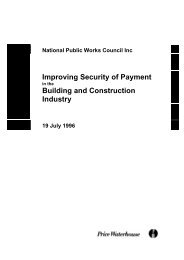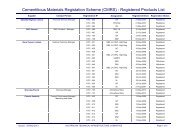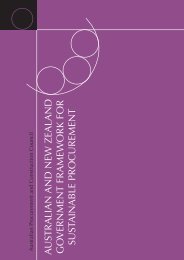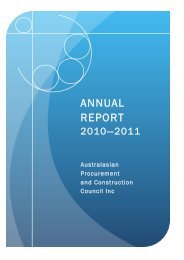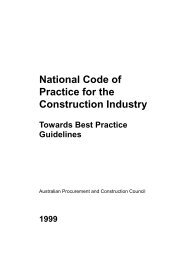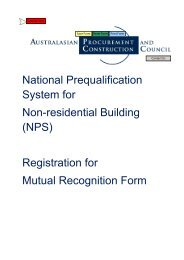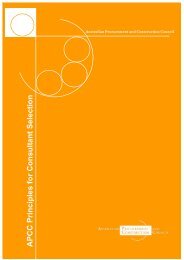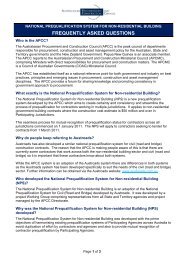ESD design guide for Australian Government buildings: Edition 2
ESD design guide for Australian Government buildings: Edition 2
ESD design guide for Australian Government buildings: Edition 2
You also want an ePaper? Increase the reach of your titles
YUMPU automatically turns print PDFs into web optimized ePapers that Google loves.
esd opportunities in building<br />
OPPORTUNITY 4<br />
minimising energy use<br />
“One of the problems with air<br />
based systems is that they<br />
don’t turn down very well. And<br />
when they get to this low load<br />
situation… they per<strong>for</strong>m badly<br />
and get into all sorts of problems<br />
… yet this is the situation <strong>for</strong> 80%<br />
of the year.”<br />
Appropriate sizing of building systems<br />
Dr Paul Bannister, Managing Director,<br />
Exergy Australia<br />
APPROPRIATE SIZING OF<br />
LIGHTING, HEATING AND<br />
COOLING SYSTEMS<br />
Several concepts need to be<br />
understood, and considered, when<br />
choosing heating and cooling plant:<br />
Natural ventilation<br />
Uses external air and air movement to<br />
ventilate a building.<br />
Mechanical ventilation<br />
Uses machines to move the air – fans,<br />
air conditioners etc.<br />
Mixed mode ventilation<br />
Uses a mixture of natural and<br />
mechanical systems.<br />
Refrigerant cooling<br />
Uses ‘refrigerants’ in heat pump<br />
systems (such as a fridge) to move<br />
heat from one place (such as inside<br />
the fridge) to another place (such as<br />
the back or bottom of the fridge).<br />
Evaporative cooling<br />
Uses the latent energy of water<br />
evaporation to remove heat.<br />
Com<strong>for</strong>t<br />
A measure of the perception of people<br />
n a space. The Predicted Mean Vote<br />
(PMV ISO 7730-1984) and Adaptive<br />
Com<strong>for</strong>t (ASHRAE-55 25 ) systems<br />
provide appropriate measures of<br />
com<strong>for</strong>t. Together they both consider<br />
actors such as radiant temperature,<br />
humidity, radiant symmetry, air<br />
movement, occupant clothing and<br />
activity levels and external ambient<br />
temperatures.<br />
Adaptive com<strong>for</strong>t<br />
Adaptive com<strong>for</strong>t assessment<br />
methods allows the <strong>design</strong>er to<br />
produce a more efficient and smaller<br />
HVAC system.<br />
Radiant cooling/heating<br />
Radiant cooling/heating is the<br />
feeling of heat or ‘coolth’ radiating<br />
from a nearby element (such as<br />
brick wall that has been in sun). A<br />
large percentage of an individual’s<br />
sensation of thermal com<strong>for</strong>t is from<br />
radiant heat.<br />
Mechanical plant size<br />
Taking passive <strong>design</strong> elements into<br />
account means that in many cases<br />
the size of the mechanical plant can<br />
be reduced. Setting realistic building<br />
energy needs is also important. This<br />
requires an understanding of how<br />
the building will be used, how many<br />
people will be using it, and <strong>for</strong> how<br />
many hours.<br />
For example the energy needs <strong>for</strong><br />
a 24 hour building that houses a<br />
call centre, with their people and<br />
equipment intensive workspaces,<br />
will be different to a nine-to-five<br />
office housing maintenance staff <strong>for</strong><br />
Canberra parks. They may only be in<br />
their office half of the time and spend<br />
most of their time in the field.<br />
Lighting<br />
Lighting needs to be optimised <strong>for</strong><br />
the tasks that will be per<strong>for</strong>med. The<br />
simplest ways of minimising energy<br />
consumption from lighting are to<br />
consider:<br />
• energy efficiency fluorescent tubes<br />
(T5 or T8 depending on sitting and<br />
use of light)<br />
• use of natural light<br />
• use of electronic ballasts (7% more<br />
efficient)<br />
• user controls.<br />
25 ANSI / ASHRAE Standard 55-2004, Thermal<br />
Environmental Conditions <strong>for</strong> Human Occupancy.<br />
020<br />
<strong>ESD</strong> DESIGN GUIDE FOR AUSTRALIAN GOVERNMENT BUILDINGS


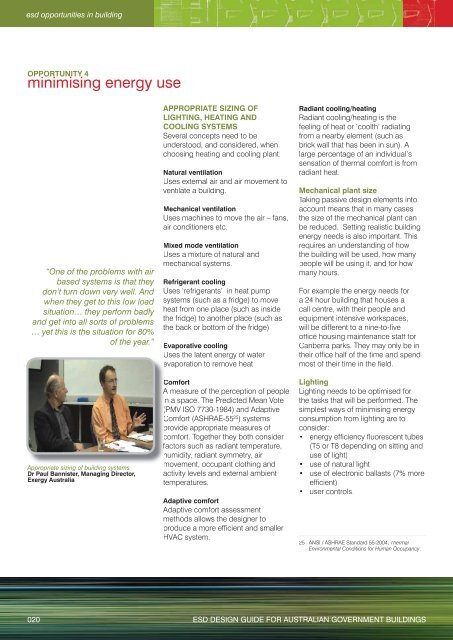
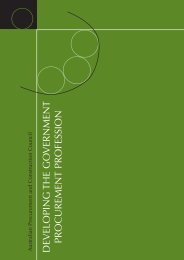
![NATIONAL COST ADJUSTMENT PROVISION EDITION 2 [NCAP2]](https://img.yumpu.com/48266135/1/184x260/national-cost-adjustment-provision-edition-2-ncap2.jpg?quality=85)
